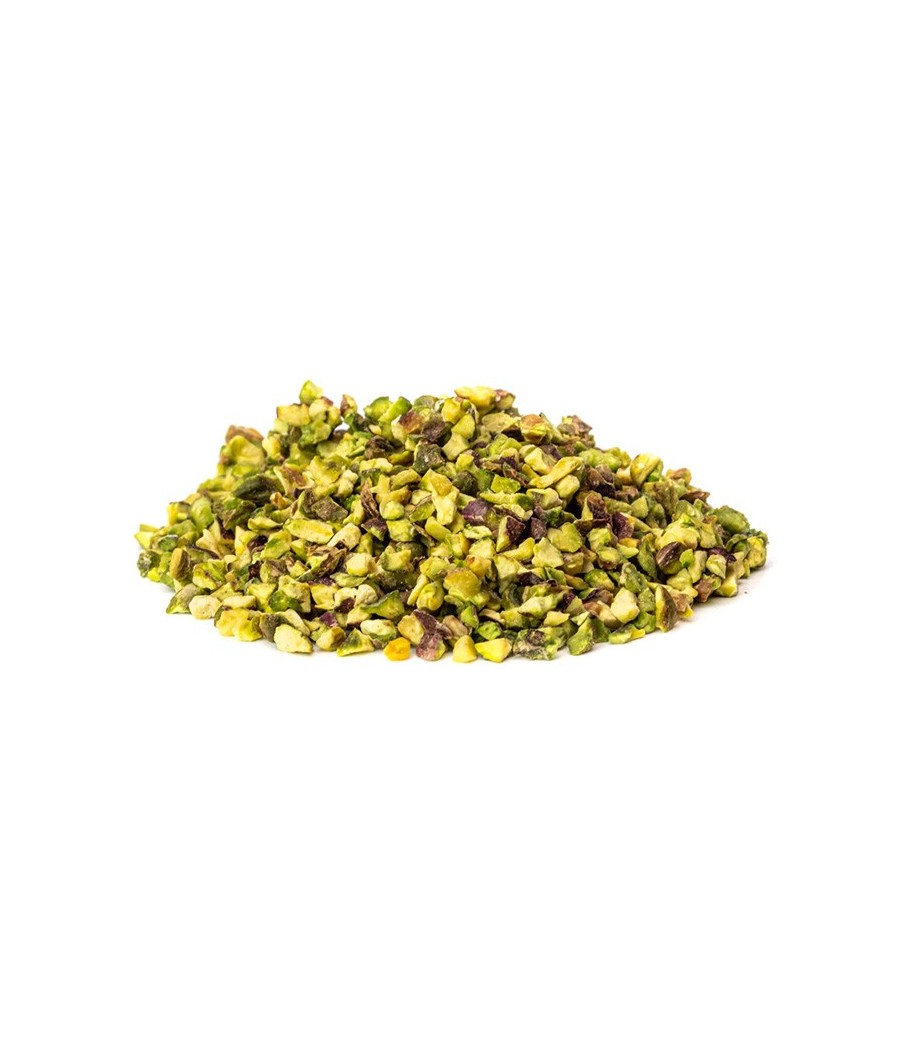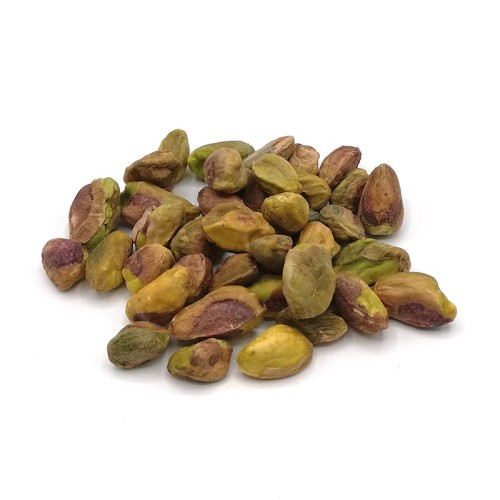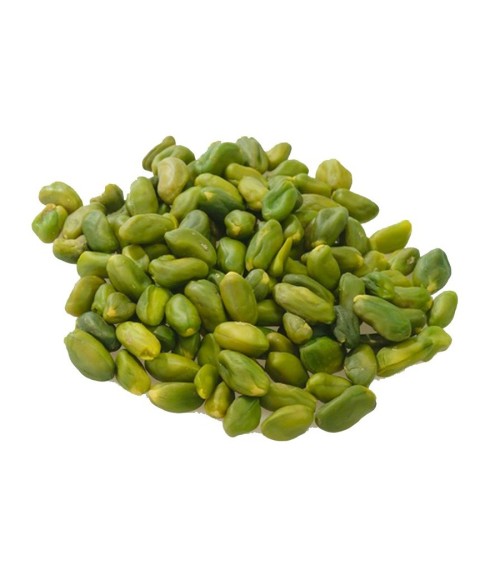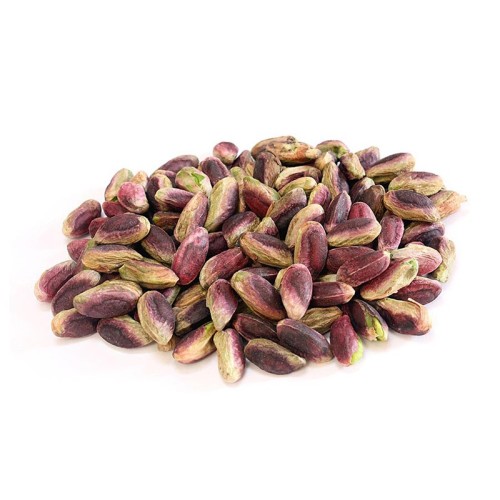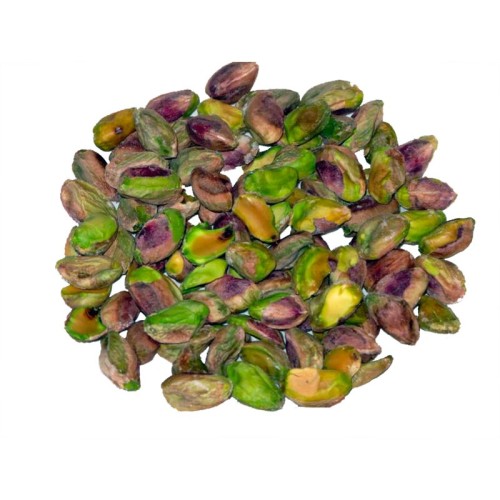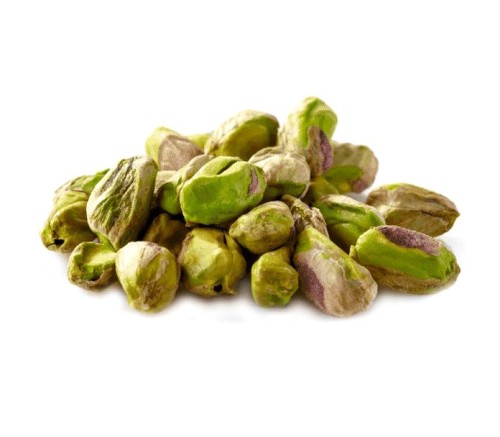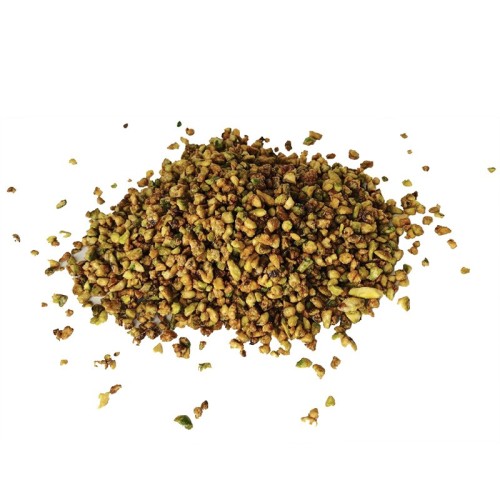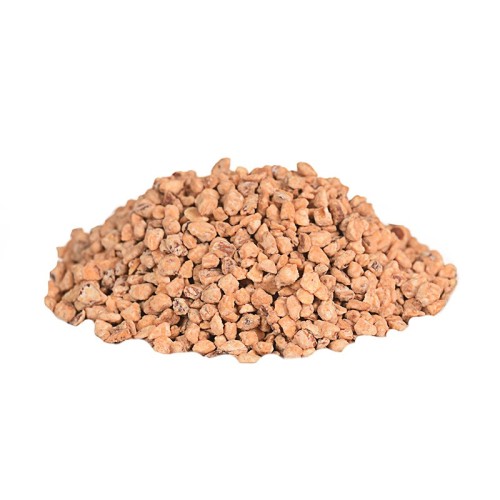Standard Pistachio Crumbles (2-4 mm)
(€38.29 Per Kg)
Pistachio Crumbles, perfect for decorations and preparations in pastry and cooking. Made with high-quality pistachios, it is available in a professional format (vacuum-sealed bags of 1 or 5 Kg) to ensure maximum versatility and authentic flavor.
 Security policy
Security policy
Transparency and reliability - Encrypted information (SSL Certificate)
 Delivery policy
Delivery policy
Fast shipping with delivery in 1- 4 working days.
 Return policy
Return policy
24/7
Pistachio Crumbles Standard (2-4 mm), an excellent product made with carefully selected pistachios. Ideal for Ho.Re.Ca. professionals, pastry chefs, and cooks, as well as cooking enthusiasts seeking a high-quality ingredient.
This pistachio crumble is perfect for decorating cakes, ice creams, and desserts, as well as enriching savory dishes like gourmet salads, tartares, and pasta dishes. Its standard size (2-4 mm) ensures uniform distribution and a flawless aesthetic in every preparation.
Available in a 5 kg vacuum-sealed package, designed to preserve the product's freshness and fragrance, ideal for intensive professional use.
Data sheet
- Product
- Pistachio
Specific References
- ean13
- 8054134417304
Nutritional values
| Ingredients | PISTACHIOS. May contain traces of PEANUTS and other NUTS. |
| Method of conservation | Keep in a cold and dry place. |
| Nutrition declaration | average values per 100 g: |
| Power | 2504 kJ / 605 kcal |
| Fats | 51 g |
| of which saturated fatty acids | 5.3g |
| Carbohydrates | 8.8g |
| of which sugars | 6.0 g |
| Fibers | 9.5g |
| Protein | 23 g |
| Salt | 0.01 g |
| Phosphorus | 464 mg (66% NRV*) |
| Copper | 0.71 mg (71% NRV*) |
| Vitamin B6 | 0.99 mg (71% NRV*) |
| Directions | The advice given IS NOT IN ANY WAY TO BE CONSIDERED OF MEDICAL/PRESCRIPTIVE VALUE. The information provided is for informational and informative purposes only, therefore they are not intended in any way to replace medical advice. In the presence of pathologies you should always consult your doctor. |
| Origin | Italy |
| Nutrients | Phosphorus, Copper, Vitamin B6 |
| Vnr | *Nutritional Reference Value |
| Label and packaging | The images are included for illustrative purposes, the product may undergo changes based on stock availability and the selected weight. |
| Product | Pistachios |
Curiosity
The pistachio (Pistacia vera) is a tree of the Anacardiaceae family, with an average height of around 4-5 meters, but which can even exceed 8-10 meters and reach an age of 300 years. Pistachio grows in areas where winters are cool and summers are long and hot. It flowers in April-May and has female and male apetal flowers on various plants. The fruit is a drupe with an oval endocarp with a thin and hard shell, containing the seed commonly called "pistachio", which is bright green under a purple skin. The harvest takes place from the end of August to October. The plant bears fruit every two years and, for this reason, the plantations are made in different times and places, so as to be able to have an approximately constant harvest every year.
Pistachios are used both shelled and peeled , often toasted and salted, even in confectionery. to prepare ice creams, creams, drinks; and for the production of cured meats (mortadella Bologna, for example) or as a condiment for first and second courses.
The pistachio provides an oil used in pastry , in confectionery, as well as in cosmetics for its emollient qualities. In popular medicine, the habit of using the infusion of the bark as a refresher is widespread, especially in the areas of Sicily where the pistachio is grown. Legend has it that pistachio was grown by King Nabocodonosor in the Hanging Gardens of Babylon for his wife Amytis. In the first century AD, the emperor Vitellius introduced pistachios to Rome. Marcus Gavius Apicius includes pistachio in his classic recipe book of Early Roman cuisine.
Pistachio is a satisfying snack , very nutritious, rich in fiber and vitamins. A typical portion corresponds to about 30 grams of shelled pistachio, equal to about 160 calories. Depending on the size of the pistachios, this is equivalent to about 30-40 seeds, which is a satisfying snack with a high and prolonged sense of satiety due to the high content of proteins, fats and dietary fibres. In addition to being very tasty, it is the most nutritious type of nut as it contains eight important substances: thiamin, vitamin B6, copper, manganese, potassium, fiber, phosphorus and magnesium, in addition to the greatest quantities of polyphenolic antioxidants. Although the function of antioxidants is not yet fully known, the research conducted so far underlines the benefits of a healthy diet with foods containing antioxidants.
Sources
Nutspaper “The pistachio” 1/2009
Nutspaper “American Pistachios” 1/2011
History
The word " pistachio " derives from the Arabic term fustaq and from the persia pesteh : both names are onomatopoeic and recall the sound produced by the shell which opens when fully ripe. The origin of the genus Pistacia can be traced back to the Tertiary era, thanks to the discovery of fossil residues found on the island of Madeira . Other archaeological finds have shown that the pistachio was used since 7000 BC, in Turkey, as food. The diffusion of the various species in different areas has been ascertained, but limiting the investigation to Pistacia vera, it would be native to Syria or to a much wider area, including also Asia Minor, Palestine and Turkmenistan. According to legend, pistachio was grown by King Nabochadnezzar in the Hanging Gardens of Babylon for his wife Amytis .
Pistachio cultivation is very ancient ; in fact, it is referred to in the Bible , when it is said that Jacob sent various fruits as a tribute to the Pharaoh, including pistachios (Genesis 43:11). Pistachio was known to the Assyrians , Persians and Greeks as a medicinal drug . Its culture developed in western Asia, where it was found by Alexander the Great in the 3rd century BC; the pistachio was then brought to Rome in 30 AD by Lucio Vitellio , governor general of Syria, and later spread to Spain by Pompeo Crassus. Marco Gavio Apicius includes pistachio in his classic recipe book of Roman cuisine of the first empire. The diffusion of the pistachio gradually includes China , Caucasian Russia and for about a century the United States of America where the plant was introduced by the "Office of ForeignSeeds and PlantsIntroduction ". Although in Italy the pistachio was used in various recipes from the very beginning, north of the Alps it was mainly considered an expensive pastry ingredient . Only after the Second World War did the pistachio's image gradually transform, being enjoyed as a popular snack . In the United States they were typically colored red to mask imperfections and attract consumer attention: “a dozen for five cents” soon became a familiar slogan.
The world's largest pistachio producer is Iran with an average annual production of over 230,000 tons, followed by the United States with around 110,000 tons, then by Turkey, China, Syria, Greece, Italy, Afghanistan, Pakistan and India. In Iran, most pistachios are grown in the provinces of Rafsanjan and Kerman. Iran covers about 54% of the entire world production and has its largest market in Western Europe. Imported mainly in the round variety, the Iranian pistachio is highly appreciated thanks to its excellent quality and flavour.
California , whose production covers about 22% of the world share, produces a pistachio with substantially different characteristics from the Iranian one, with a lighter shell without spots, but much less tasty. The American pistachio is mainly consumed in the domestic market, in the Far East and in Eastern Europe. The third producing country, Turkey, with about 78,000 tons and a market share of 14%, has a variety very similar to the Iranian long, medium-small sized and of excellent quality, with a very pleasant flavour. Syria produces about 29,000 tons of an excellent pistachio, however consumed almost exclusively in the internal market, where the product is sold fresh and where it is used for the production of oil. The peculiarity of Syria is that of having a very closed market and protected by an import duty of 50%, which effectively prevents the entry of the product from foreign countries. Greek production is about 9,000 tons per year, lower than domestic consumption, which essentially makes it an importing country.
Sources
Nutspaper “The pistachio” 1/2009
Nutspaper “American Pistachios” 1/2011
storage
You can keep the chopped pistachios in cool, dry places, away from sources of heat and humidity. Here are 4 useful tips:
- The ideal condition for maintaining the pistachio grains is in a refrigerated environment. Pistachio grains can also be stored without problems at room temperature during the winter season given the low temperatures. During the summer, on the other hand, it is advisable to keep it in the fridge or in the coolest possible place, as the increase in temperatures could favor the deterioration of the products.
- The ideal container in which to keep the chopped pistachios is glass . In fact, thanks to its constitution it is impenetrable to chemical and gaseous agents, and having excellent thermal insulating capacity it maintains the initial temperature for a longer time compared to other materials. If the glass is colored, so much the better: using colored glass prevents the entry of some wavelengths of light (including ultraviolet light) and therefore some nutritional and organoleptic characteristics remain unaltered.
- The type of closure of the container is also important: an airtight cap ensures that the food is protected from excessive contact with oxygen which can lead to lipid oxidation and which can be essential for aerobic bacteria.
- The environment should always be well ventilated : by ventilating the rooms, the internal humidity that escapes from the window is kept under control, guaranteeing the right balance, which helps to discourage the onset of moulds.
Recommended doses
30 g of chopped pistachios provide:
- 21% of the nutritional reference value of copper;
- 21% of the nutritional reference value of Vitamin B6;
- 20% of the nutritional reference value of Phosphorus.
Individual needs vary according to age, gender, weight and physical activity. A varied and balanced diet and a healthy lifestyle are the basis of your well-being.
Property
100 g of shelled pistachios in grains contain:
- Vitamin E (8.7 mg - 73% NRV)
- Copper (0.71 mg - 71% NRV)
- Vitamin B6 (0.99 mg - 71% NRV)
- Phosphorus (464 mg - 66% NRV)
- Potassium (960 mg - 48% NRV)
- Manganese (0.85mg - 43% NRV)
- Vitamin K (31 μg - 41% NRV)
- Magnesium (127 mg - 34% NRV)
- Biotin (15 μg - 30% NRV)
- Iron (3.4 mg - 24% NRV)
- Zinc (2.1 mg - 21% NRV)
- Selenium (10 μg - 18% NRV)
No customer reviews for the moment.

